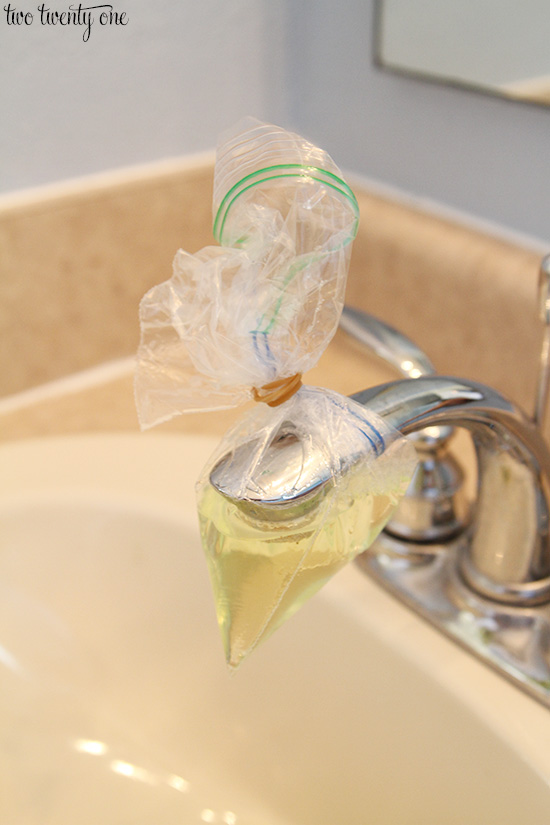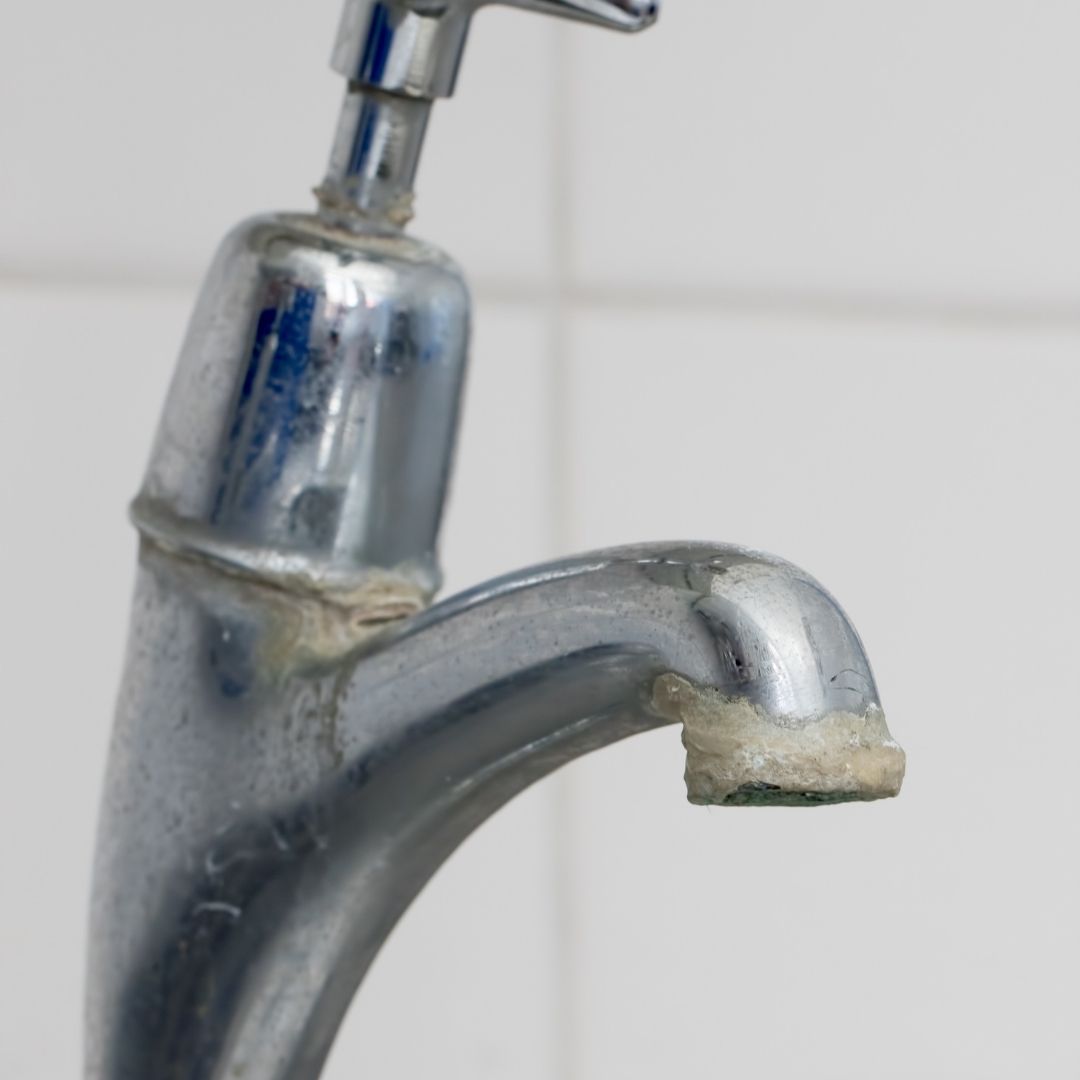Imagine turning on your faucet, only to be greeted by a sputtering stream of water struggling to escape through a layer of unsightly white crust. You’re not alone.
Calcium buildup on faucets is a common issue that can make your kitchen or bathroom look less than pristine. This stubborn residue not only affects the appearance of your fixtures but can also impede water flow, leading to frustration every time you need to wash your hands or rinse your dishes.
The good news? You don’t have to live with it. There’s a simple solution that will leave your faucets sparkling and efficient once more. In this guide, you’ll discover quick and effective methods to remove calcium deposits without the need for harsh chemicals or professional help. Imagine the satisfaction of seeing your faucets gleam, just like they did when they were brand new. Keep reading, and you’ll learn how to tackle this common household problem with ease and confidence.

Credit: www.twotwentyone.net
Causes Of Calcium Buildup
Calcium buildup on faucets is a common issue many homeowners face, and understanding the root causes can help in preventing it. The white, chalky deposits not only tarnish the look of your fixtures but also affect their functionality. But why does this happen in the first place?
Hard Water
One of the main culprits of calcium buildup is hard water. Hard water contains high levels of minerals, particularly calcium and magnesium. When water evaporates, it leaves these minerals behind, forming the unsightly deposits you often see on your faucet.
Infrequent Cleaning
If you don’t clean your faucets regularly, you’re more likely to see calcium buildup. Over time, the minerals accumulate and harden, making them tougher to remove. A simple routine of wiping down your faucets can make a significant difference.
Old Plumbing Systems
Older plumbing systems might contribute to increased calcium deposits. Pipes and fixtures from previous decades are often more susceptible to mineral accumulation. Consider whether your plumbing system might need an update if calcium buildup is a frequent issue.
High Mineral Content In Local Water Supply
The mineral content in your local water supply can vary greatly. Some areas naturally have higher levels of calcium in their water. This can make it more challenging to keep your faucets free from buildup, even with regular cleaning.
Have you ever wondered why some households seem to battle with calcium deposits more than others? Understanding these causes can guide you towards more effective prevention strategies. So, next time you spot that chalky residue, you’ll know exactly why it’s there and what you can do about it.
Signs Of Calcium Deposits
Calcium deposits can make your faucet look unattractive. These deposits are hard and white. They form due to minerals in water. Recognizing these signs early can prevent bigger problems. Let’s explore the common signs of calcium buildup.
White Or Cloudy Spots
Notice white spots on your faucet? These are calcium deposits. They often appear on shiny surfaces. Over time, they become more visible. They can be stubborn and difficult to remove.
Reduced Water Flow
Calcium can block water flow. It builds up in faucet nozzles. This leads to weak water pressure. Regular cleaning helps maintain normal flow.
Crusty Or Rough Surfaces
Feel a rough texture on your faucet? This might be calcium. It creates a crusty layer on metal surfaces. This layer can damage your faucet over time.
Dull Or Tarnished Finish
Calcium can dull shiny finishes. It leaves faucets looking old and worn. Regular care keeps them shiny and new.
Natural Cleaning Methods
Calcium buildup on faucets can be annoying. It leaves ugly white spots. Luckily, natural methods can tackle this problem. They are safe for your home and environment. Plus, they are easy to use.
Vinegar Solution
Vinegar is a powerful cleaner. It dissolves calcium deposits effectively. Mix equal parts of vinegar and water. Pour the solution into a spray bottle. Spray directly on the affected area. Let it sit for 15 minutes. Scrub with a toothbrush. Rinse with warm water. Repeat if needed.
Baking Soda Paste
Baking soda is a gentle abrasive. It lifts away stubborn deposits. Create a paste with baking soda and water. Apply it to the faucet. Use a cloth or sponge. Scrub in circular motions. Rinse with warm water. Enjoy the shine!
Lemon Juice Application
Lemon juice breaks down calcium naturally. It leaves a fresh scent behind. Squeeze lemon juice onto the faucet. Let it sit for 10 minutes. Use a brush to scrub. Rinse with water afterward. This method works wonders.

Credit: www.youtube.com
Commercial Cleaners
Dealing with calcium buildup on your faucet can be frustrating. Commercial cleaners offer a reliable solution to tackle this stubborn problem. These products are specifically designed to break down mineral deposits, saving you time and effort. But how do you choose the right cleaner, and what’s the best way to apply it?
Choosing The Right Product
Not all commercial cleaners are created equal. Some are designed for quick results, while others focus on eco-friendliness. Look for products with clear instructions and reputable reviews. If you prefer something less harsh, opt for cleaners labeled as biodegradable or non-toxic.
Consider your faucet material. Brass, chrome, or stainless steel may require different formulations. A cleaner that’s effective on stainless steel might damage brass finishes. Always read the label carefully to ensure compatibility with your fixtures.
Application Tips
Before applying the cleaner, test it on a small, inconspicuous area. This ensures it won’t damage your faucet’s finish. Once tested, follow the instructions precisely. Over-application can lead to unwanted residue or discoloration.
Use a soft cloth or sponge for application. Abrasive materials can scratch the surface, making future calcium buildup worse. Apply the cleaner evenly, and let it sit for the recommended time. Then, rinse thoroughly with water to remove all traces of the product.
Are you in a hurry? Some cleaners work faster when paired with a little elbow grease. Gently scrub the affected area to speed up the process. Just be cautious not to apply too much pressure.
Have you ever tried a commercial cleaner only to find it didn’t work as expected? Share your experiences or tips in the comments below. Your insights could help someone else make the right choice!
Preventing Future Buildup
Keep faucets clean by regularly wiping them with vinegar to prevent calcium buildup. Drying faucets after use also helps. This simple routine reduces the risk of future buildup and keeps your fixtures shiny.
Preventing calcium buildup on faucets helps keep them shiny and efficient. Regular care stops mineral deposits from forming. This makes your bathroom and kitchen look cleaner. It also ensures smooth water flow. By adopting some simple habits, you can enjoy spotless faucets for longer.Regular Maintenance
Regular cleaning is crucial to prevent calcium buildup. Wipe the faucet with a soft cloth every few days. This removes water spots and prevents mineral deposits. Use mild soap and warm water. Avoid harsh chemicals that damage the surface. Check the aerator regularly. It can collect deposits and restrict water flow. Unscrew it and rinse under running water. Use a toothbrush to scrub away stubborn buildup.Using Water Softeners
Hard water often causes calcium buildup. Water softeners can help reduce this problem. These devices remove minerals like calcium and magnesium. Install a water softener in your home. It protects not only faucets but also appliances and pipes. Choose a system that fits your needs and budget. Consult a professional for the best advice. Regularly check and maintain the softener for optimal performance.
Credit: nuvoh2o.com
When To Call A Professional
Stubborn calcium buildup on your faucet may need professional help. Persistent stains or damage can indicate it’s time. Specialized tools and expertise ensure a proper fix, keeping your fixtures in top condition.
Calcium buildup on faucets can be a frustrating issue. While many DIY methods can tackle the problem, there are times when it’s wise to call a professional. Knowing when to make that call can save you time and prevent further damage to your fixtures.Understanding The Severity
Sometimes, the buildup can be more than just a surface issue. If you’ve tried multiple methods without success, it may indicate a deeper problem. Stubborn deposits might be a sign of hard water issues in your plumbing system. You might need expert advice on water softening solutions or a more thorough examination of your pipes.Safety Concerns
Are you worried about damaging your faucet with chemical cleaners or aggressive scrubbing? Professionals have the tools and knowledge to remove calcium without harming your fixtures. If your faucet is made from delicate materials, calling an expert is a safer option. They can ensure the integrity of your fittings while effectively removing buildup.Long-term Solutions
If calcium buildup is a recurring issue, a professional can offer long-term solutions. They might suggest installing a water softener or making adjustments to your plumbing system. These solutions can minimize future buildup, saving you time and effort in the long run. Wouldn’t it be nice to have one less household chore?Personal Experience Insight
I once attempted to tackle a stubborn calcium deposit with vinegar and baking soda. Hours later, the buildup remained, and my faucet looked worse for wear. Calling a professional not only resolved the issue quickly, but they also educated me on preventing future buildup. Sometimes, it’s worth admitting defeat for a better solution.Cost Vs. Benefit
Think about the cost of continuous DIY attempts versus a one-time professional fix. You might find that hiring a professional is more cost-effective. They can address the issue efficiently, saving you from buying multiple cleaning products or tools. Would you rather spend your weekend scrubbing or enjoying leisure time? Considering these points can help you decide whether to tackle the problem yourself or call a professional. Making the right choice can save you time and preserve the quality of your faucets.Frequently Asked Questions
How Do You Remove Hard Limescale From Faucets?
Remove hard limescale using a vinegar solution. Soak a cloth in vinegar and wrap it around the faucet. Leave for 30 minutes. Scrub with a toothbrush, rinse thoroughly, and repeat if needed. Use baking soda for extra scrubbing power. Regular cleaning prevents limescale buildup.
How Do You Decalcify A Faucet?
Decalcify a faucet by mixing equal parts vinegar and water. Soak a cloth in the solution and wrap it around the faucet. Leave it for 30 minutes. Scrub gently with a brush to remove any remaining scale. Rinse thoroughly with water to finish.
Repeat if necessary for stubborn deposits.
Will Vinegar Dissolve Calcium Buildup?
Yes, vinegar dissolves calcium buildup effectively. Acetic acid in vinegar breaks down mineral deposits, making surfaces clean. Use white vinegar for best results. Apply vinegar directly, let it sit, then scrub or rinse. Regular use prevents future calcium buildup.
How Long To Leave Clr On Faucet?
Leave CLR on the faucet for 2-3 minutes to effectively dissolve mineral deposits. Scrub gently with a brush for better results and rinse thoroughly with water. Always follow product instructions for safety and optimal cleaning.
What Causes Calcium Buildup On Faucets?
Calcium buildup occurs due to hard water. It leaves mineral deposits on surfaces. Regular cleaning can help.
Conclusion
Clear faucets improve your home’s look. Removing calcium is simple with regular care. Natural solutions are often effective. Vinegar and baking soda help dissolve buildup. Scrub gently to avoid scratches. Rinse thoroughly to remove residue. Keeping your faucet clean prevents future issues.
Regular maintenance saves time and effort. A clean faucet ensures smooth water flow. Enjoy a shiny, spotless fixture. Follow these steps to maintain freshness. Your faucet will thank you with a lasting shine. Remember, clean faucets contribute to a healthy home.
Act now for a cleaner, brighter space.
